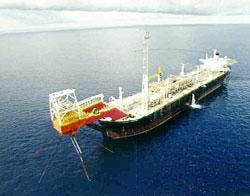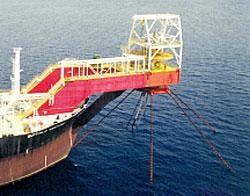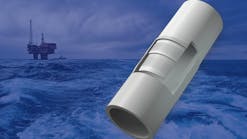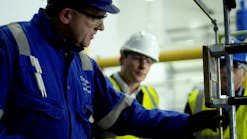Teamwork yields 2-month investment return for Buffalo FPSO
Ken Fitzpatrick
Nexen Petroleum Australia Pty Ltd.
R. Cole
P. Keefe
Schlumberger
On Dec. 29, 1999, the Buffalo Venture FPSO produced first oil for BHP Petroleum and Nexen. This was well within the project schedule and under budget for the Timor Sea field. Within 48 hours, the facility was producing in excess of its 40,000 b/d design capacity. Since then, it has had a production uptime of 98%.
BHP, in partnership with Nexen Petroleum Australia Pty Ltd., undertook the FPSO project when oil was priced at $11/bbl. By the time production came online, the price had climbed to $29/bbl. The increase enabled the overall project to pay out completely in less than two months. In early 2000, the Buffalo partners told the Asian press that the project was the fastest full-conversion FPSO development it had ever undertaken.
The partners let the overall contract for leasing the Buffalo Venture FPSO to Modec Inc. of Japan, a subsidiary of Mitsui Group. In November 1998, Modec in turn contracted with Schlumberger Compression and Production Systems in Singapore to supply the production facilities. Just nine months later, three skid modules had been installed on the newly restored MT Spirit tanker, which was shortly recommissioned as the Buffalo VentureFPSO. Collectively, the skids are capable of processing a minimum of 40,000 b/d of oil and 8 MMcf/d of compressed gas, and treating a base capacity of 30,000 b/d of produced water.
The non-propelled Buffalo Venture FPSO is permanently moored over the Buffalo field in the Timor Sea, about 560 km northwest of Darwin.
In addition to the construction and leasing tender won by the Modec/Schlum- berger team, this partnership was also awarded the ongoing operations contract for the Buffalo Venture FPSO. In July 2001, Nexen assumed full operatorship from BHP for this venture.
Field development
The Buffalo oil field in the Timor Sea is about 560 km northwest of Darwin and inside Australian waters. BHP is the field operator in a 50/50 partnership with Nexen Petroleum. BHP classified the 20-MMbbl (proven and probable) field as marginal and decided from the onset to produce it at high rates over three years. Thus, the field was developed using two wells connected to an unmanned minimum wellhead platform on a shallow, 3-m bank about 2 km from the FPSO. The FPSO receives and processes the fluids, then stores them in cargo tanks. When the FPSO is full, a shuttle tanker offtakes the oil through a flexible hose connected to the stern of the vessel. This cycle will continue throughout the life of the field.
Process module design/construction
The Schlumberger IPM project management and engineering team contributed to the project as engineering designers and construction managers of the FPSO process modules. These modules:
- Separate the oil, gas, and water phases
- Stabilize the oil
- Compress the produced gas to provide gas lift
- Treat and discharge produced water to envir- onmental specifications
- Flare small quantities of excess gas not consumed by the system.
The process facility was delivered in three large, customized modules consisting of a 20-m by 25-m crude stabilization and water treatment skid, a 20-m by 20-m gas dehydration and compression skid, and an 8-m by 13-m flare skid. The total combined weight of the three skids is about 1,100 tons.
Buffalo field currently produces from two wells connected to an unmanned minimum wellhead platform on a shallow, 3-m bank about 2 km from the FPSO. This platform is connected to the Buffalo Venture FPSO via a mooring system, as shown.
The process facilities' special design called for a minimum or base output of 40,000 b/d of oil, 30,000 b/d of water, and 8 MMcf/d of gas lift compression. There is future expansion capability of 60,000 b/d of oil, 45,000 b/d of water, and 12 MMcf/d of gas. The plant was configured so debottlenecking could be done with minimal expense offshore in case of additional discoveries or tie-ins on the field.
The construction schedule required a fast-track approach. The process modules were successfully designed and built under difficult circumstances and in a short timeframe. The entire design, procurement, and fabrication cycle took only nine months. Skid components were largely fabricated in Singapore, Indonesia, and Malaysia, with the main module integration and shipyard conversion being done in Singapore.
Teamwork
Buffalo represents the first time BHP let a contract for the construction and ownership of an FPSO. In the past, the company handled this process itself. Modec had never joined with an outside firm to manufacture and manage process equipment. Schlumberger did not typically have client personnel housed in its offices.
To meet the tight time and cost targets for the Buffalo project, such accommodations were necessary.
From project inception, personnel from all companies were assembled into a small, single multidisciplinary team. External specialists who could bring expertise and efficiencies to the mix were added, as needed. Typically, such a project is handled by assembling internal teams. This flexibility led to operator personnel working out of Schlumberger offices for project oversight and decision-making, and Schlumberger subcontracting some of the detailed engineering work.
At project's end, this unique arrangement contributed to project efficiency. For example, during the engineering phase, a design review meeting with the Buffalo partners, Modec, and Schlumberger led to agreement on basic process system concepts. Further revisions were made as a result of the design review. The design, however, was not frozen and released until each company was satisfied with the results of an intensive hazard and operability study.
A cooperative solution was also required to meet two other project criteria:
- Maximum use of Australian content
- Minimum crew onboard the operating FPSO.
To address these needs, Schlumberger took bids from Australian fabrication yards for process module construction and pressure vessel fabrication, which entailed more automated functions in the final product than is typical. Automation and cross training has allowed a crew of just 18 people (one from the operators, and 17 from Modec and Schlumberger combined) to successfully operate the Buffalo Venture. This compares to a typical FPSO crew of 25-50 people. Crewmembers underwent rigorous competency-based training and assessment in Singapore while fabrication was taking place to ensure they could handle the assignment.
HSE
As many as 200 people were working on the Buffalo Venture during its final construction stages, with no lost-time incidents. All three companies involved adhered to strict safety guidelines during the 255,000 total project man-hours logged. This included three key criteria:
- Mandatory use and enforcement of job safety analysis procedures
- Requirements for all primary vendors to produce project-specific health, safety, and environment (HSE) plans
- Full-time employment of an onsite HSE advisor.
Project quality was assured by developing and implementing a quality plan that met ISO 9001 requirements. In fact, the Buffalo Venture construction project was used to obtain ISO 9001 certification from Det Norske Veritas. A series of exhaustive independent quality audits by the project partners found no major non-conformances in the quality system implemented. It is believed that adhering to quality standards has led to the 98% uptime achieved by the FPSO to date, which is producing products within specifications and in excess of 50,000 b/d of oil.
Operating the FPSO
Cooperative teamwork and multitasking continue to be key to successfully operating and maintaining the Buffalo Venture. The Modec/ Schlumberger operations team arrived early at the shipyard and played a critical role both in the physical completion of the work and the commissioning of the equipment. In addition, Oilphase personnel were added during the start-up phase to verify that the actual oil produced met the design criteria of the process equipment.
When the operating team passed the 100-day mark with no lost time incidents, the Buffalo Venture project was distinguished as having the lowest manning level of any FSPO operating off Australia.
Industry standard
Within one week of coming online, the Buffalo Venture FPSO exceeded its design criteria, producing 50,000 b/d of oil for the Buffalo partners. The entire project paid for itself in less than two months, further proving the success of the teamwork model applied to this project. By the summer of 2000, the Buffalo project had become BHP's new standard for FPSOs.
At present time the project is running at 6,500 b/d of oil and has cleared 800 days lost-time-incident free. Nexen is preparing for a two-well, infill development drilling program using the Ocean Heritage to extend field reserves and increase production to 26,000 b/d of oil. Field life is anticipated to extend into 2004.







